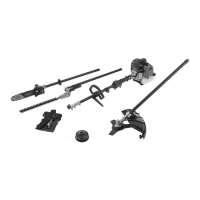www.scheppach.com
44
|
GB
You can nd out how to dispose of the disused
device from your local authority or city adminis-
tration.
Fuels and oils
• Before disposing of the unit, the fuel tank and the
engine oil tank must be emptied!
• Fuel and engine oil do not belong in household
waste or drains, but must be collected or disposed
of separately!
• Empty oil and fuel tanks must be disposed of in
an environmentally friendly manner.
Storing the equipment
If you intend to store the equipment for longer than 30
days, the equipment must be prepared accordingly.
Otherwise the fuel still remaining in the carburetor will
evaporate and leave a rubbery sediment. This can
cause problems when starting up the equipment and
may require expensive repairs.
1 Slowly remove the fuel tank cap to release any
pressure that may have formed in the tank. Care-
fully empty the tank.
2 To remove the fuel from the carburetor, start the
engine and let it run until the equipment stops.
3 Leave the engine to cool (approx. 5 minutes).
4 Remove the spark plug (see section 10 Change
and clean the spark plug).
5 Add one teaspoon of 2-stroke engine oil into the
combustion chamber. Slowly pull the starter cord
several times to apply a layer of oil to all internal
components. Fit the spark plug again.
Note: Store the equipment in a dry place and far
away from possible ignition sources such as an oven,
a gas-red hot water boiler, a gas red dryer, etc.
Putting the equipment back into operation
1 Remove the spark plug (see section 10 Change
and clean the spark plug).
2 Quickly tug on the starter cord to remove excess
oil from the combustion chamber.
3 Clean the spark plug and check that the electrode
gap is correct, or insert a new spark plug with the
correct electrode gap.
4 Prepare the equipment for operation.
5 Fill the tank with the relevant mixture of fuel and
oil. See the section „Fuel and oil“.
Transport
To transport the machine, empty the petrol tank as
described in section 8 draining fuel. Clean coarse dirt
o the equipment with a brush or hand brush.
Always attach the transport guard to all cutting tools.
Fig. 1 (14a, 15a, 17a)
In order to prevent damage and injury, secure the tool
against tipping over and sliding when transporting it
in vehicles.
12. Disposal and recycling
Notes for packaging
The packaging materials are
recyclable. Please dispose of
packaging in an environmen-
tally friendly manner.

